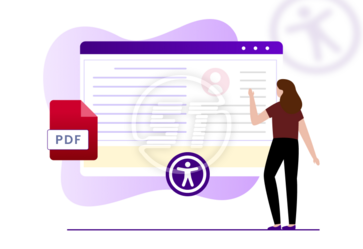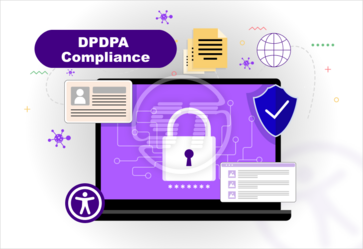WordPress is one of the most popular platforms powering more than 35% of all the websites. It has become the backbone of various web applications due to its reasonable learning curve, suitable even for simpler websites, and also enjoys great community support contributing new themes, services, plugins, and to the core project as well. It’s ease-of-use has created a strong affinity towards it that it has become a go-to platform even for non-technical users. Even those with more robust needs can also set up their websites in a matter of minutes with extended WordPress plugins and application features.
But what about the accessibility options of WordPress? How difficult it is for the clients to keep up with the ADA guidelines? Let’s dive in!
If you’re half-through the design of your WordPress website or you are switching themes, or you’re just migrating to WordPress for the first time, wherever you are in the journey of WordPress usage, there is no perfect time for you to adopt ADA compliance guidelines and ensure that your WordPress website is accessible to everyone.
What is WordPress ADA Compliance?
ADA is an acronym for the Americans with Disabilities Act (ADA), a U.S. federal law passed in 1990 to protect citizens with disabilities. It offers protection against discriminations just like the Civil Rights Act, 1964. As per the Title III regulations, businesses must provide accommodations for the disabled by removing any barriers that hinder their access to the products and services. Going by this regulation, many businesses started to offer wheelchair ramps, accessible options in the public restrooms, and more.
With the constant evolution of the internet, more and more businesses started going digital and the internet has become an indispensable part of everyday life. Accordingly, Title III of ADA Compliance extended to include even web accessibility. It encompasses virtual barriers along with the earlier physical ones. Today, businesses have to face lawsuits if they do not design their digital sources as per the ADA compliance measures.
How to ensure your WP Web Accessibility?
ADA compliance guidelines have been here for more than 2 decades. However, WordPress owners are slowly catching on. Many WordPress website owners have faced legal cases and also realized the cons of non-compliance. Their businesses were crippled and put their survival in jeopardy. So, they started demanding ADA compliance websites and sought the help of experts to ensure better web accessibility. The experts began to run some tests to check the compliance score, redesign a few things, and changing the theme if required to improve the accessibility aspects of the WordPress websites.
The WordPress community has incorporated various accessibility measures to make the CMS ADA compliant. They have an accessibility team that outlines the accessibility coding standards to ensure that the platform conforms with web accessibility guidelines. However, if you’re using any other plugin or a third-party theme, then you need to take care of web accessibility measures explicitly. If you have a completed WordPress website with you, then you can audit your site for ADA compliance.
ADA Compliant WP Themes
Most WP themes are not ADA compliant by default and you may need to modify your WP theme for full compliance. Pick a theme that helps you in easy adherence to ADA guidelines. Even if you chose to develop a custom theme, be mindful of the accessibility requirements as well as guidelines. You need to make an accessibility-ready theme within your WordPress theme repository.
Accessibility-ready theme inculcates the following list:
- Keyboard navigation - The site must be easily navigable via the keyboard without the mouse.
- Controls - Appropriate semantic elements such as <input>, <a>, <button>, for site control.
- Skip Links - Enable users to bypass the navigation and skip directly to their required content.
- Forms - Well-built forms with appropriate and explicit field labels.
- Headings - Hierarchical structure for the headlines for visual differentiation.
- ARIA Landmark Roles - Entire content must be wrapped in one landmark role.
- Images - Alt attribute must be included in the image tags.
- Contrasts - A differentiable level of perceivable color contrast to pass the WCAG guidelines.
- Links - Must be underlines or color differentiated for clear navigation.
- Link Text - Avoid generic link text such as “read more”, “click here”. Instead be descriptive.
Run an ADA-compliance Test
Once you have an ADA-compliant WP theme, then run basic ADA and WCAG compliance tests and how stacked up you are. Once you have your results, you need to fix some of the errors to improve your compliant score. Some of the common errors are listed below.
- Landmarks - Landmarks usually introduce the website sections to a screen reader. To fix them, you can use headings, div, nav, main tags to your code.
- Headings - Use the heading tags H1 to H6 appropriately to maintain the hierarchical structure for easy differentiation.
- Color - To avoid light text on dark background and vice-versa, it is advised to keep the dark text on a white background and increase the font size. To make your web page fully ADA compliant, you may also add some li and ul tags for sorting the content.
- Links - Links must be descriptive and meaningful. Avoid generic content such as ‘learn more’ which is vague.
- Forms - Forms should have proper labels and neat input fields.
- Images - WCAG guidelines mandate images to have alt tags everywhere.
- Audio/Video - Stop playing them automatically. Have a clear play button for the users to find and use them when required.
Install WordPress ADA compliance Plugin
WordPress has several plugins in its repository that can help you with adding skip links, providing high-contrast widgets, enforcing alt tags on images, etc. You can install a WordPress plugin that helps you with ADA compliance. The WP Accessibility plugin is one such that can fix your website’s compliance issues by enforcing certain practices like adding ALT attributes on images. This helps with a variety of accessibility issues that usually would be addressed only with the theme changes. Though WP Accessibility supports a number of accessibility features, no plugin can ensure full accessibility. There are also plugin add-ons that comply with the ADA guidelines. You can also use Gravity Forms that make your website forms compliant.
Update Your Code
Your development team should understand that your website must be universally accessible before they make any coding-related decisions. They need to incorporate the best coding practices, themes, and plugins for better accessibility. They need to look into the accessibility checklist if they are developing any custom theme or plugin. The front-end of WordPress is perfectly capable of being accessible but it totally depends on the developer.
Content Accessibility
Content readability is one of the biggest barriers to ADA compliance. You can use media queries to adjust the content for any device. The WP Accessibility plugin has a contrast tester to try different permutations to choose the best fit. With Gutenberg editor, once can enrich the content-editing experience. You can manipulate the layout, add blocks, and add rich content having more control over web pages.
Final Thoughts
It may seem to be like a heavy investment to put your resources in ADA compliance but in the long haul, you are going to reap a multitude of benefits. Adherence to ADA compliant guidelines improve the usability of your website, enhance your user experience, build brand reputation, and also boost your conversions. You can improve your SEO rankings, save legal costs, and earn great goodwill in the market by being sensitive to the needs of everyone. If you need to conduct a WordPress ADA-compliance audit or hit any roadblocks in the process, we are here to help you.
Web accessibility is not a simple topic, mainly when it comes to WordPress ADA compliance or WordPress web accessibility. With a quick intro to WordPress Web accessibility, you are in a great place to make sure your WordPress website is living up to the requirements for ADA compliant website. We also offer ADA Compliant Website Design, Accessibility Web Development, ADA Compliance Audit, ADA Compliance Mobile App, and other ADA Compliance Services. We can develop any WordPress website, ecommerce website or WooCommerce store or Mobile app an ADA Compliant.


